NevGold Discovers High-Grade Oxide Antimony “Bullet Zone” From Surface with 2025 Step-Out Drilling: 14.90 g/t AuEq Over 4.6 Meters (3.76% Antimony And 0.29 g/t Au) Within 2.42 g/t AuEq Over 53.3 Meters (0.57% Antimony And 0.22 g/t Au) at Limo Butte, Nevada
globenewswire.com
October 16, 2025 07:30 ET | Source: NevGold Corp.
Vancouver, British Columbia, Oct. 16, 2025 (GLOBE NEWSWIRE) -- NevGold Corp. (“NevGold” or the “Company”) (TSXV:NAU) (OTCQX:NAUFF) (Frankfurt:5E50) is pleased to announce the discovery of high-grade oxide antimony in the new antimony-gold “Bullet Zone” from surface at its Limousine Butte Project (the “Project”, “Limo Butte”) in Nevada. The Bullet Zone was discovered with a plus 150 meter step-out drillhole from 2025 drilling that was testing NevGold’s new geology model at the Project. The Bullet Zone discovery significantly expands the gold-antimony mineralization footprint at the Resurrection Ridge target area, which NevGold is advancing to an initial gold-antimony Mineral Resource Estimate (“MRE”).
Key Highlights
- Discovery of the Bullet Zone with new 2025 step-out drilling intercepts the highest-grade antimony (“Antimony”, “Sb”) interval drilled to date at the Project, with grades up to 8.9% Sb:
- LB25-002 Upper Zone (from surface): 14.90 g/t AuEq* over 4.6 meters (3.76% Sb and 0.29 g/t Au), within 2.42 g/t AuEq* over 53.3 meters (0.57% Sb and 0.22 g/t Au)
- LB25-002 Lower Zone: 0.82 g/t AuEq* over 32.0 meters (0.68 g/t Au and 0.04% Sb), within 0.58 g/t AuEq* over 57.9 meters (0.45 g/t Au and 0.03% Sb)
- *Gold equivalents (“AuEq”) are based on assumed metals prices of US$3,000/oz of gold and US$40,000 per tonne of antimony (~30% discount to current spot prices), and assumed metals recoveries of 80% for gold and 75% for antimony.
- New NevGold geological model is confirmed with positive drilling intercepting gold-antimony mineralization below the older thrusted dolomite unit:
- Discovering the high-grade antimony intercept in the antimony-gold Bullet Zone below the older thrusted dolomite unit opens up large untested areas with significant mineralization potential at the Project (see Figure 1, Figure 2, Figure 3, Figure 6)
- Drilling for mineralization below the older thrusted dolomite unit was a new target concept that the Company tested and proved with results from LB25-002
- Over 150 meter step-out and discovery of the Bullet Zone significantly expands the mineralization footprint at Resurrection Ridge; the Company intends to advance both Resurrection Ridge and Cadillac Valley to an initial gold-antimony Mineral Resource Estimate (“MRE”)
- 11 drillholes have been completed in the current 2025 drill campaign with assays pending
- Positive samples at surface up to 6.8% antimony and 0.25 g/t Au found in road cuts during construction of the new 2025 drill pads (see Figure 1); the new drill pads are focused on expansion areas and show the extensive mineralization potential at the Project
- Phase II metallurgical testwork on gold and antimony continues to advance with results expected over the coming weeks
Limo Butte Planned 2025 Activities / Status Update
NevGold will continue its active exploration program at Limo Butte including:
- Evaluating the historical geological database with focus on gold and antimony (completed);
- Analyzing historical drilling with focus on gold and antimony (continuous activity);
- Advancing metallurgical testwork (in progress, Phase II results in coming weeks);
- Continuing to drill test gold-antimony targets (ongoing, 11 drillholes completed to date);
- Completing initial gold-antimony Mineral Resource Estimate (MRE) (in progress).
NevGold CEO, Brandon Bonifacio, comments: “We are extremely excited about the discovery of the high-grade antimony intercept in the new oxide gold-antimony Bullet Zone from surface. The geological concept of drilling below the older, thrusted dolomite unit was a target that our team developed over the past couple of years working at Limo Butte. The fact that we intercepted some of the highest grade mineralization that we have drilled to date at Limo Butte on the 1st hole testing this target concept is exceptional and a testament to our technical team. The discovery of the Bullet Zone also significantly expands the mineralization footprint at Resurrection Ridge, and opens large areas of the Project overlain by dolomite, with no historical drilling.”
Bonifacio continues: “We are also well-positioned with Limo Butte to support the United States critical minerals strategy as the Project has both gold and antimony, and both commodities have reached all-time high prices this year. There is a clear commitment from government officials to advance high-quality, domestic, mineral projects and Limo Butte is well-advanced with its significant near-surface, oxide gold-antimony mineralization and large geological database. We are also progressing another key milestone, which is the Phase II metallurgical testwork on the gold-antimony metallurgical flowsheet building on our positive results from Phase I. All of these various work programs will help us rapidly demonstrate the gold-antimony potential at Limo Butte as we progress the asset to the next stages of project development with the objective of playing a key part in the mandate to create a vertically integrated, U.S. antimony supply chain.”
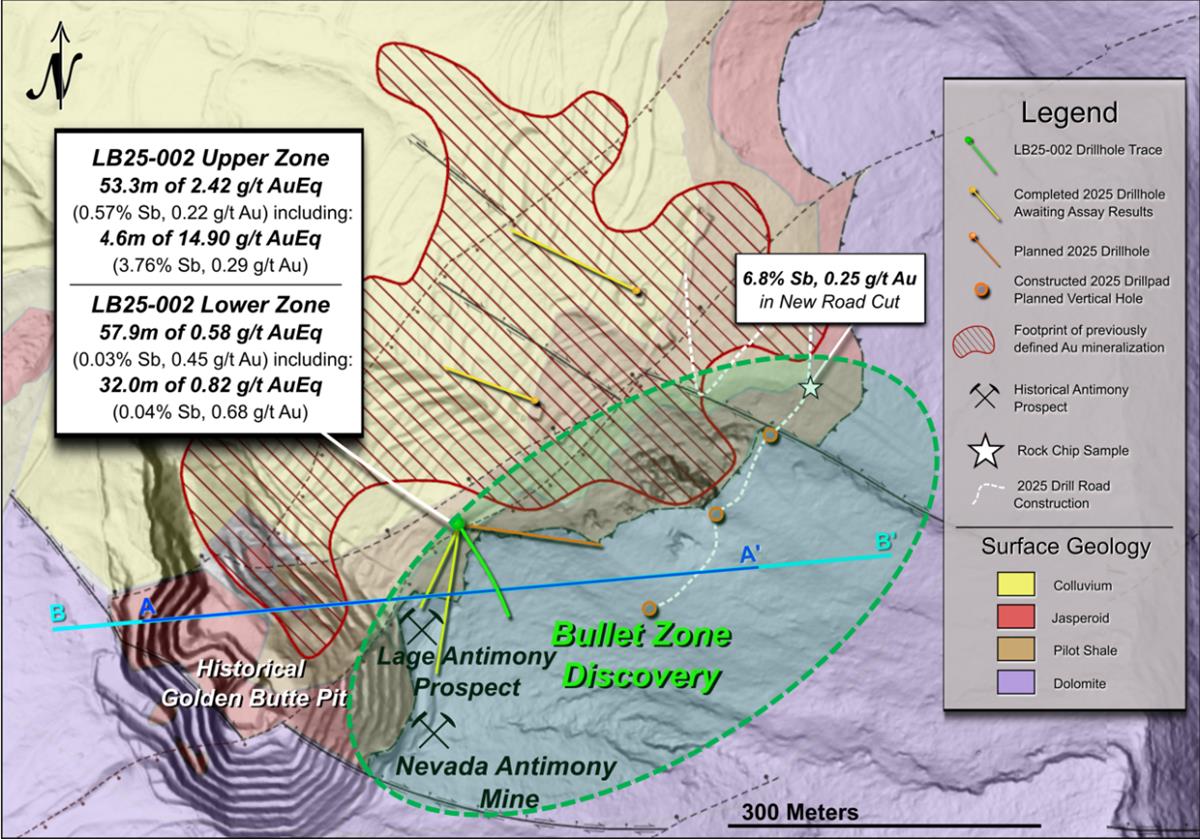
Figure 1 – Resurrection Ridge target area with the new Bullet Zone discovery from LB25-002. Figure also includes the 2025 drillpads and identified expansion areas with the thrust faulted Upper Plate Dolomite. Red outline is current mineralization footprint at Resurrection Ridge, with +150 meter step-out to the east with Hole 25-002 and discovery of the Bullet Zone. To view image please click here

Figure 2 – Cross section with results from LB25-002 and new Bullet Zone discovery. Thin colored discs show Antimony (Sb ppm) in drilling, and wide colored discs show Gold (Au ppm) in drilling. To view image please click here

Figure 3 – Large cross section at the Project outlining the strong expansion potential between Resurrection Ridge and Crashed Airplane Valley, which spans +2.5 kilometers. To view image please click here
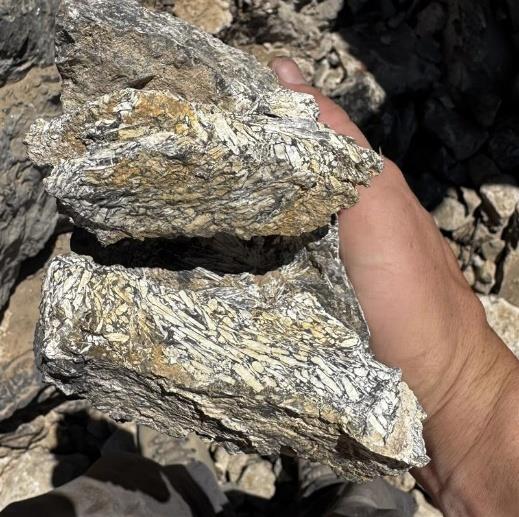
Figure 4 – Sample from road cut building new 2025 drill pads which assayed 6.8% antimony and 0.25 g/t Au in newly identified expansion part of the Project around the Bullet Zone discovery. Elongated white crystals are stibiconite (Sb3O6(OH)). To view image please click here
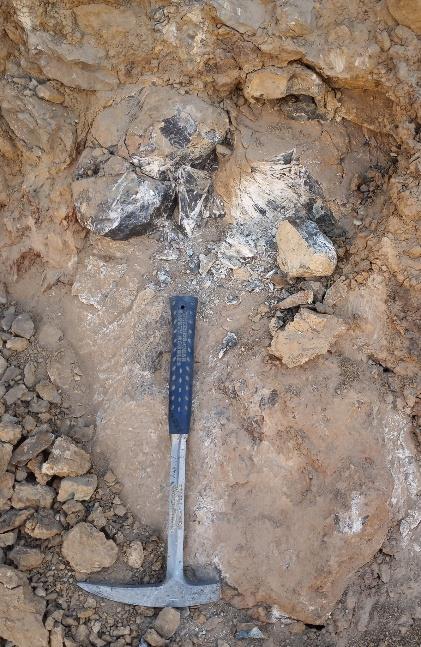
Figure 5 – Sample area from drill pad from drillhole LB25-002, which discovered the high-grade Bullet Zone, showing strong stibiconite and stibnite mineralization. To view image please click here
2025 Drill Results
| Hole ID | Length, m* | g/t Au | % Sb | g/t AuEq** | From, m | To, m | | Resurrection Ridge – Bullet Zone | | LB25-002 Upper | 53.3 | 0.22 | 0.57% | 2.42 | 3.0 | 56.4 | | including | 32.0 | 0.31 | 0.84% | 3.60 | 19.8 | 51.8 | | including | 4.6 | 0.29 | 3.76% | 14.90 | 39.6 | 44.2 | | LB25-002 Lower | 57.9 | 0.45 | 0.03% | 0.58 | 150.9 | 208.8 | | including | 32.0 | 0.68 | 0.04% | 0.82 | 164.6 | 196.6 |
*Downhole thickness reported; true width varies depending on drill hole dip and is approximately 70% to 90% of downhole thickness.
**The gold equivalents (“AuEq”) are based on assumed metals prices of US$3,000/oz of gold and US$40,000 per tonne of antimony (~30% discount to current spot prices), and assumed metals recoveries of 80% for gold and 75% for antimony.
Limo Butte – Updated Geological Model Summary
The Devonian Pilot Shale (“Pilot Shale”, “Pilot”) is the principal local host to Carlin-type mineralization at Limousine Butte. At Limousine Butte, positive gold grades commonly coincide with silicification and jasperoid breccias within the Pilot Shale, an alteration style also observed where elevated antimony is reported.
NevGold’s 2021–2025 work included integrating historical drilling, new mapping, and surface sampling which produced an updated district model and refined property-wide controls on mineralization. At Resurrection Ridge, Devonian–Silurian dolomite is exposed immediately east of known gold-antimony mineralization. Earlier explorers inferred that the overlying Pilot Shale had been eroded in this area, and they did not test eastward, despite shallow high-grade intercepts in the easternmost holes drilled at Resurrection Ridge. The new model indicates the older dolomite was thrust over the prospective Pilot Shale unit, creating structural preparation and a fluid trap that preserves the favorable host at depth, the classic architecture for a Carlin-type system.
Hole LB25-002, the first test of this new NevGold geological model, collared in dolomite, passed through the upper thrust plate, and intersected gold and antimony at multiple horizons within the Pilot Shale. This drillhole result validates the model and materially expands the potential mineralization footprint: the preserved Pilot Shale extends more than one kilometer east of prior drilling at Resurrection Ridge.

Figure 6 – Comparison of historical geological model (left) and new NevGold geological model (right) outlining the thesis that the older dolomite unit was thrust over the prospective Pilot Shale unit. The preserved Pilot Shale unit extends more than 1 kilometer east of prior drilling at Resurrection Ridge. To view image please click here
Property-wide, the updated model outlines multiple Au–Sb target corridors that track outcrops and projected subsurface positions of the Pilot Shale, where repeated faulting and thrusting provided fluid pathways and focused mineralization. NevGold’s 2025 drill program continues to test these high-priority targets.
Historical records within the project boundary document two small-scale antimony prospects—the Nevada Antimony Mine and the Lage Antimony Prospect (Figure 1). The Nevada Antimony Mine extracted stibnite (Sb2S3) from a hydrothermal breccia via shallow pits; the Lage prospect similarly reports limited antimony production. Complementing these records, rock-chip sampling from the Golden Butte pit (Brigham Young University thesis) returned numerous assays exceeding 1% Sb in jasperoid breccias, with several over 5% Sb, including a sample grading 9.6% Sb with visible stibnite and stibiconite ( BYU Thesis Report ).
Together, these datasets support a district-scale interpretation in which thrust repetition preserves the Pilot Shale at depth east of Resurrection Ridge and focuses Au–Sb mineralization along structurally prepared horizons, establishing multiple high-priority targets for step-out drilling and follow-up work.
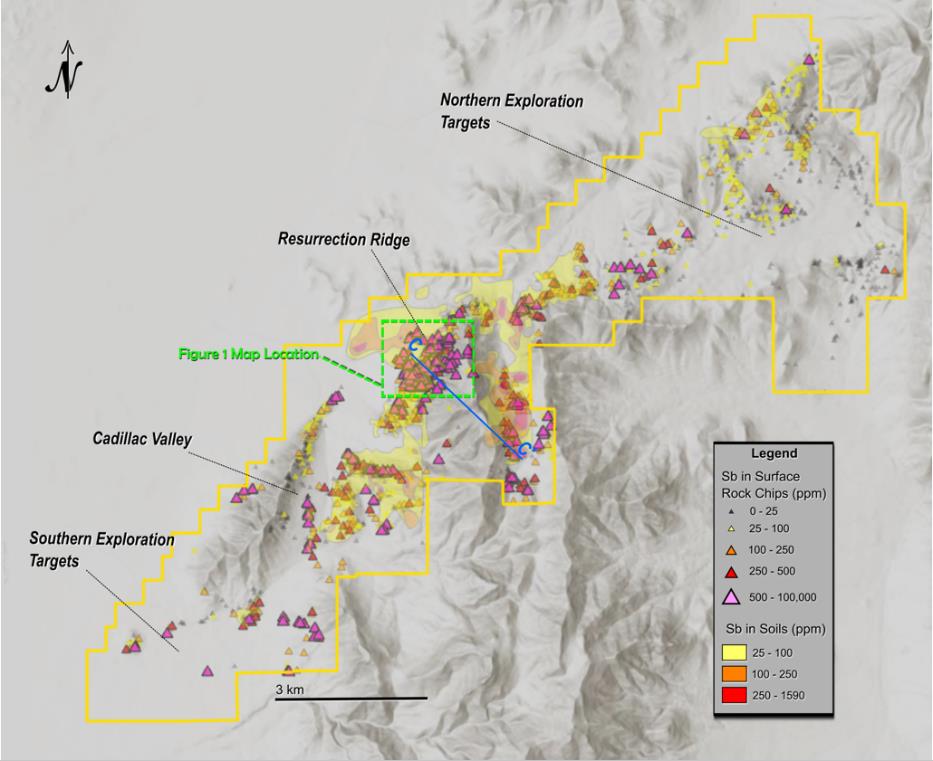
Figure 7 – Limousine Butte Project with historical antimony in rock chips and soils. The total strike length between Resurrection Ridge and Cadillac Valley is +5km. To view image please click here
Drillhole Orientation Details
| Hole ID | Target Zone | Easting | Northing | Elevation (m) | Length (m) | Azimuth | Dip | | LB25-002 | Bullet Zone (RR) | 667078 | 4417219 | 2176 | 225.6 | 145 | -65 |
US Executive Order – Announced March 20, 2025
The Company is pleased to report the sweeping Executive Order to strengthen American mineral production and reduce U.S. reliance on foreign nations for its mineral supply. Antimony (Sb) has been identified as an important “Critical Mineral” in the United States essential for national security, clean energy, and technology applications, yet no domestically mined supply currently exists.
The Executive Order invokes the use of the Defense Production Act as part of a broad United States (“US”) Government effort to expand domestic minerals production on national security grounds. As it relates to project permitting, the Order states that it will “identify priority projects that can be immediately approved or for which permits can be immediately issued, and take all necessary or appropriate actions…to expedite and issue the relevant permits or approvals.” Furthermore, the Order includes provisions to accelerate access to private and public capital for domestic projects, including the creation of a “dedicated mineral and mineral production fund for domestic investments" under the Development Finance Corporation (“DFC”).
This decisive action by the US Government highlights the urgent need to expand domestic minerals output to support supply chain security in the United States. This important Order will help revitalize domestic mineral production by improving the permitting process and providing financial support to qualifying domestic projects.
Importance of Antimony
Antimony is considered a “Critical Mineral” by the United States based on the U.S. Geological Survey’s 2022 list (U.S.G.S. (2022)). “Critical Minerals” are metals and non-metals essential to the economy and national security. Antimony is utilized in all manners of military applications, including the manufacturing of armor piercing bullets, night vision goggles, infrared sensors, precision optics, laser sighting, explosive formulations, hardened lead for bullets and shrapnel, ammunition primers, tracer ammunition, nuclear weapons and production, tritium production, flares, military clothing, and communication equipment. Other uses include technology (semi-conductors, circuit boards, electric switches, fluorescent lighting, high quality clear glass and lithium-ion batteries) and clean-energy storage.
Globally, approximately 90% of the world’s current antimony supply is produced by China, Russia, and Tajikistan. Beginning on September 15, 2024, China, which is responsible for nearly half of all global mined antimony output and dominates global refinement and processing, announced that it will restrict antimony exports. In December-2024, China explicitly restricted antimony exports to the United States citing its dual military and civilian uses, which further exacerbated global supply chain concerns. (Lv, A. and Munroe, T. (2024)) The U.S. Department of Defense (“DOD”) has designated antimony as a “Critical Mineral” due to its importance in national security, and governments are now prioritizing domestic production to mitigate supply chain disruptions. Projects exploring antimony sources in North America play a key role in addressing these challenges.
Perpetua Resources Corp. (“Perpetua”) has the most advanced domestic gold-antimony project in the United States. Perpetua’s project, known as Stibnite, is located in Idaho approximately 130 km northeast of NevGold’s Nutmeg Mountain and Zeus projects. Positive advancements at Stibnite including the technical development and permitting has led to US$75 million in Department of Defense (“DOD”) awards, and over $1.8 billion in indicative financing from the Export Import Bank of the United States (“US EXIM”) ( see Perpetua Resources News Release from April 8, 2024) (Perpetua Resources. (2025))
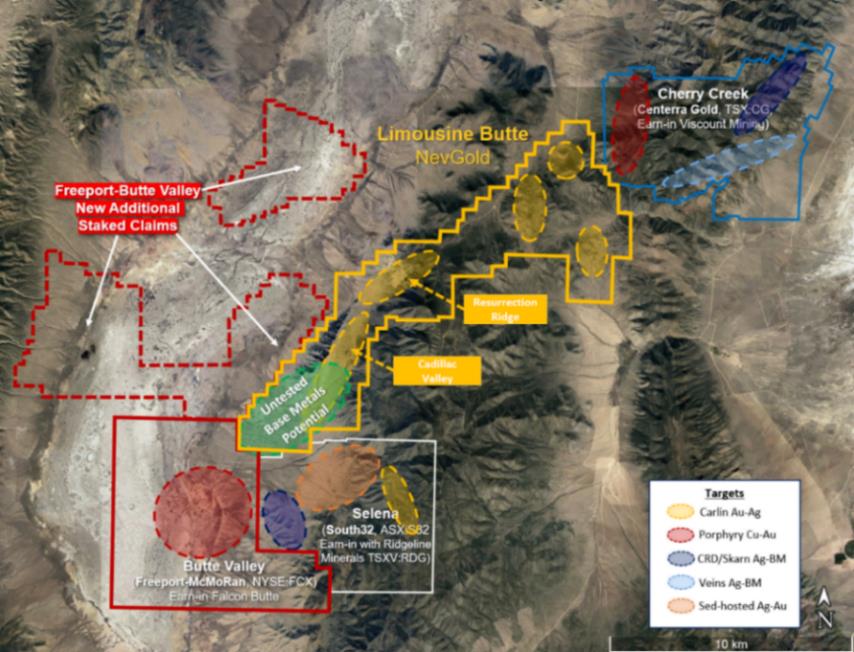
Figure 8 – Limousine Butte Land Holdings and District Exploration Activity To view image please click here
ON BEHALF OF THE BOARD
“Signed”
Brandon Bonifacio, President & CEO
For further information, please contact Brandon Bonifacio at bbonifacio@nev-gold.com, call 604-337-4997, or visit our website at www.nev-gold.com.
Sampling Methodology, Quality Control and Quality Assurance
NevGold QA/QC protocols are followed on the Project and include insertion of duplicate, blank and standard samples in all drill holes. A 30g gold fire assay and multi-elemental analysis ICP-OES method was completed by ISO 17025 certified American Assay Labs, Reno.
The historic data collection chain of custody procedures and analytical results by previous operators appear adequate and were completed to industry standard practices. For the Newmont and US Gold data a 30g gold fire assay and multi-elemental analysis ICP-OES method MS-41 was completed by ISO 17025 certified ALS Chemex, Reno or Elko Nevada.
Geochemical ICP (5g) analysis for the Wilson, Christianson and Tingey report was completed by Geochemical Services Inc. and the XRF analyses (glass disk or pellets) by Brigham Young University.
Technical information contained in this news release has been reviewed and approved by Greg French, CPG, the Company’s Vice President, Exploration, who is NevGold’s Qualified Person (“QP”) under National Instrument 43-101 and responsible for technical matters of this release.
About the Company
NevGold is an exploration and development company targeting large-scale mineral systems in the proven districts of Nevada and Idaho. NevGold owns a 100% interest in the Limousine Butte and Cedar Wash gold projects in Nevada, and the Nutmeg Mountain gold project and Zeus copper project in Idaho.
Neither the TSX Venture Exchange nor its Regulation Services Provider (as that term is defined in the policies of the TSX Venture Exchange) accepts responsibility for the adequacy or accuracy of this release.
Cautionary Note Regarding Forward Looking Statements
This news release contains forward-looking statements that are based on the Company’s current expectations and estimates. Forward-looking statements are frequently characterized by words such as “plan”, “expect”, “project”, “intend”, “believe”, “anticipate”, “estimate”, “suggest”, “indicate” and other similar words or statements that certain events or conditions “may” or “will” occur. Forward-looking statements include, but are not limited to, the proposed work programs at Limousine Butte, the exploration potential at Limousine Butte, and future potential project milestones such as the potential Mineral Resource Estimate (“MRE”). Such forward-looking statements involve known and unknown risks, uncertainties and other factors that could cause actual events or results to differ materially from estimated or anticipated events or results implied or expressed in such forward-looking statements. Such risks include, but are not limited to, general economic, market and business conditions, and the ability to obtain all necessary regulatory approvals. There is some risk that the forward-looking statements will not prove to be accurate, that the management’s assumptions may not be correct or that actual results may differ materially from such forward-looking statements. Accordingly, readers should not place undue reliance on the forward-looking statements. Any forward-looking statement speaks only as of the date on which it is made and, except as may be required by applicable securities laws, the Company disclaims any intent or obligation to update any forward-looking statement, whether as a result of new information, future events or results or otherwise. Forward-looking statements are not guarantees of future performance and accordingly undue reliance should not be put on such statements due to the inherent uncertainty therein.
References
Blackmon, D. (2021) Antimony: The Most Important Mineral You Never Heard Of. Article Prepared by Forbes.
Kurtenbach, E. (2024) China Bans Exports to US of Gallium, Germanium, Antimony in response to Chip Sanctions. Article Prepared by AP News.
Lv, A. and Munroe, T. (2024) China Bans Export of Critical Minerals to US as Trade Tensions Escalate. Article Prepared by Reuters.
Lv, A. and Jackson, L. (2025) China’s Curbs on Exports of Strategic Minerals. Article Prepared by Reuters.
Perpetua Resources. (2025) Antimony Summary. Articles and Videos Prepared by Perpetua Resources.
Sangine, E. (2022) U.S. Geological Survey, Mineral Commodity Summaries, January 2023. Antimony Summary Report prepared by U.S.G.S
U.S.G.S. (2022) U.S. Geological Survey Releases 2022 List of Critical Minerals. Reported Prepared by U.S.G.S
Wilson, D.,J., Christiansen, E., H., and Tingey, D., G., 1994, Geology and Geochemistry of the Golden Butte Mine- A Small Carlin- Type Gold Deposit in Eastern Nevada: Brigham Young University Geology Studies, v.40, P.185-211. BYU V.40 P.185-211. |




